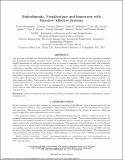| dc.contributor.author | Domingues, Diana | |
| dc.contributor.author | Miosso, Cristiano J. | |
| dc.contributor.author | Rodrigues, Suélia F. | |
| dc.contributor.author | Silva Rocha Aguiar, Carla | |
| dc.contributor.author | Lucena, Tiago F. | |
| dc.contributor.author | Miranda, Mateus | |
| dc.contributor.author | Rocha, Adson F. | |
| dc.contributor.author | Raskar, Ramesh | |
| dc.date.accessioned | 2015-01-07T16:41:37Z | |
| dc.date.available | 2015-01-07T16:41:37Z | |
| dc.date.issued | 2014-02 | |
| dc.identifier.issn | 0277-786X | |
| dc.identifier.uri | http://hdl.handle.net/1721.1/92729 | |
| dc.description.abstract | Our proposal in Bioart and Biomedical Engineering for a ective esthetics focuses on the expanded sensorium and investigates problems regarding enactive systems. These systems enhance the sensorial experiences and amplify kinesthesia by adding the sensations that are formed in response to the physical world, which aesthetically constitutes the principle of synaesthesia. In this paper, we also present enactive systems inside the CAVE, con guring compelling experiences in data landscapes and human a ective narratives. The interaction occurs through the acquisition, data visualization and analysis of several synchronized physiological signals, to which the landscapes respond and provide immediate feedback, according to the detected participants' actions and the intertwined responses of the environment. The signals we use to analyze the human states include the electrocardiography (ECG) signal, the respiratory ow, the galvanic skin response (GSR) signal, plantar pressures, the pulse signal and others. Each signal is collected by using a speci cally designed dedicated electronic board, with reduced dimensions, so it does not interfere with normal movements, according to the principles of transparent technologies. Also, the electronic boards are implemented in a modular approach, so they are independent, and can be used in many di erent desired combinations, and at the same time provide synchronization between the collected data. | en_US |
| dc.language.iso | en_US | |
| dc.publisher | Society of Photo-Optical Instrumentation Engineers (SPIE) | en_US |
| dc.relation.isversionof | http://dx.doi.org/10.1117/12.2042590 | en_US |
| dc.rights | Article is made available in accordance with the publisher's policy and may be subject to US copyright law. Please refer to the publisher's site for terms of use. | en_US |
| dc.source | SPIE | en_US |
| dc.title | Embodiments, visualizations, and immersion with enactive affective systems | en_US |
| dc.type | Article | en_US |
| dc.identifier.citation | Domingues, Diana, Cristiano J. Miosso, Suélia F. Rodrigues, Carla Silva Rocha Aguiar, Tiago F. Lucena, Mateus Miranda, Adson F. Rocha, and Ramesh Raskar. “Embodiments, Visualizations, and Immersion with Enactive Affective Systems.” Edited by Margaret Dolinsky and Ian E. McDowall. The Engineering Reality of Virtual Reality 2014 (February 28, 2014). | en_US |
| dc.contributor.department | Program in Media Arts and Sciences (Massachusetts Institute of Technology) | en_US |
| dc.contributor.mitauthor | Raskar, Ramesh | en_US |
| dc.relation.journal | Proceedings of SPIE--the International Society for Optical Engineering ; volume 9012 | en_US |
| dc.eprint.version | Final published version | en_US |
| dc.type.uri | http://purl.org/eprint/type/ConferencePaper | en_US |
| eprint.status | http://purl.org/eprint/status/NonPeerReviewed | en_US |
| dspace.orderedauthors | Domingues, Diana; Miosso, Cristiano J.; Rodrigues, Suélia F.; Silva Rocha Aguiar, Carla; Lucena, Tiago F.; Miranda, Mateus; Rocha, Adson F.; Raskar, Ramesh | en_US |
| dc.identifier.orcid | https://orcid.org/0000-0002-3254-3224 | |
| mit.license | PUBLISHER_POLICY | en_US |
| mit.metadata.status | Complete | |
